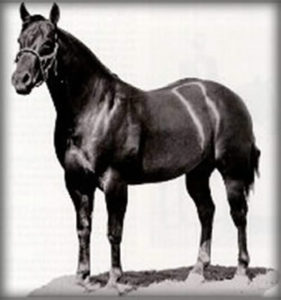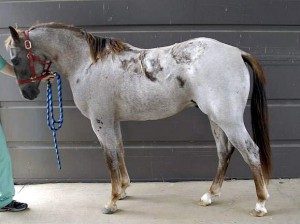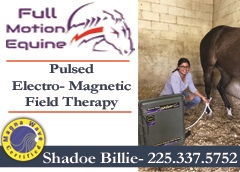By Dr. Neely Walker. Horses can be affected by a variety of genetically linked disorders. In 2009, the whole horse genome sequence was categorized. This advancement in genetics has produced affordable genetic testing, advanced management and medical treatment of affected animals, and helped to create breeding protocols that focus on reducing the impact genetic diseases have on the horse industry. Of particular interest to owners of Quarter Horses is a five (5) panel test that tests for Polysaccharide storage myopathy (PSSM), Malignant Hyperthermia (MH), Hyperkalemic Periodic Paralysis (HYPP), Hereditary Equine Regional Dermal Asthenia (HERDA), and Glycogen Branching Enzyme Deficiency (GBED). Additionally, beginning in 2015, the American Quarter Horse Association began requiring that ALL stallions must have a 5-panel genetic test complete before their 2016 foals can be registered.
Polysaccharide Storage Myopathy (PSSM) – is a dominant autosomal hereditary condition caused by the mutation of the glycogen synthase 1 (GYS1) gene. This disease creates a muscle condition similar to tying up that affects 11% of Quarter Horses. Since it is a dominant condition, only 1 copy of the GYS1 gene needs to be present for its offspring to be affected. There are three potential test results:
- P1/P1– this means your horse is positive for the dominant PSSM gene mutation, and carries two copies of the GYS1 gene. Horses that are homozygous (having 2 copies) will pass the disease to 100% of their offspring.
- n/P1- this means your horse has 1 copy of the GYS1 gene, and it is affected by PSSM. Horses that are heterozygous (having 1 copy) will pass the disease to 50% of their offspring.
- n/n- this horse is negative for PSSM and cannot pass on the gene mutation to any offspring and should not display any symptoms of the disease.
Horses who have inherited the genetic mutation causing PSSM overproduce glycogen, which leads to excess sugar stored in the muscle that is not easily accessed during exercise. The exercise will cause an energy deficit within the muscle causing muscle pain, stiffness, skin twitching, sweating, weakness, reluctance to move, gait abnormalities, mild colic, and mild muscle wasting. These horses should be maintained on a low-starch and low-sugar diet with regular and consistent exercise.
Malignant Hyperthermia (MH) – is an autosomal dominant disease caused by mutation in the ryanodine receptor 1 (RyR1). This disease creates a rare muscle disorder that affects any horse related to a Quarter Horse. Since it is a dominant disease only 1 copy of RyR1 is required for the condition to exist. There are three potential test results:
- MH/MH- this means your horse is positive for the MH mutation and indicates that they carry two copies of the mutated gene. Homozygous horses will pass the disease onto 100% of its offspring.
- n/MH– this means your horse has one copy of the MH mutation and indicated the horse is positive for MH. Heterozygous horses have a 50% chance of spreading this disease to its offspring.
- n/n– this horse is negative for MH and does not carry the gene mutation. This horse will not pass the condition onto its offspring and will not be affected by the disease.
Horses that have inherited the MH gene have a malfunctioning calcium-release channel within skeletal muscle cells. This causes excess calcium to be released into the portion of the cell that causes contractions and increases muscle metabolism. Horses affected by MH may not show any physical signs of the disorder until it is triggered by extreme exercise, stress, or specific anesthetic (halothane). Horses experiencing symptoms of MH will have a fever often exceeding 109 F, excessive sweating, increased heart rate, abnormal heart rate, high blood pressure, acidosis, and muscle damage. If not treated immediately this condition can be fatal. Horses that are affected by MH can be managed during surgery if known prior to the procedure.
Hyperkalemic Periodic Paralysis Disease (HYPP)- is an autosomal dominant disease caused by point mutation in the SCN4A gene that affects 1.5% of Quarter Horses and up to 56% of Halter horses. HYPP is a muscular disease that has been traced back to a Quarter Horse stallion named Impressive. Since it is a dominant disease only one copy of the mutation is needed for the condition to exist. There are three potential test results:
- H/H– this means your horse carries two copies of the mutated gene. This horse will pass this disease to 100% of its offspring and is positive for HYPP.
- n/H– this means your horse carries one copy of the mutated gene. This horse is affected with HYPP and has a 50% it will pass the disease onto its offspring.
- n/n– this horse is negative for HYPP, shows no symptoms, and cannot pass it on to offspring.
Horses affected by HYPP have a mutation in the sodium-potassium pump system that is involved in controlling muscle contraction. This disease causes involuntary muscle contraction that may result in tremors, temporary paralysis and respiratory dysfunction and even death. Positive horses need to be maintained on a strict diet and exercise program to reduce excess potassium in their diet and help them maintain appropriate muscle function. Owners of positive horses should be cautious when riding or handling these horses as HYPP attacks are unpredictable.
Hereditary Equine Regional Dermal Asthenia (HERDA) – is an autosomal recessive diseased caused by a mutation in peptidyl-prolylisomerase B (PPIB) gene that affects 3.5% of Quarter Horses. HERDA is a disease that causes a collagen deficiency in horses that restricts adhesion of the skin layers that has been linked to Quarter Horse stallion Poco Bueno. Since this is a recessive disease a horse must have two copies of the mutated gene to be affected. There are three potential test results:
- Hrd/Hrd– this means your horse is positive for HERDA and carries two copies of the gene.
- Hrd/n– this means your horse is a carrier and only has one copy of the gene. This horse will not show any symptoms of the disease but will have a 50% chance of passing the mutated gene to its offspring.
- n/n- this means your horse is negative, it is not affected by HERDA, and will not pass the mutation onto any offspring.
Horses that are positive for HERDA will have multiple slow healing skin abrasions and are not typically noticed until they begin training. The friction and pressure caused by training aids and saddles will cause large sheets of skin to separate. There is no cure for the disorder and no way to effectively manage horses with HERDA, however and positive horses are typically euthanized. Breeding carrier animals is also not advised.
Glycogen Branching Enzyme Deficiency (GBED)- is an autosomal recessive disease cause by a mutation in the GBE1 gene that affects 8-10% of Quarter Horses. Paints, Appaloosas, and other descendent breeds of Quarter Horses can be affected. GBED is a fatal condition that causes the inability to properly store sugar. Since it is a recessive disease a horse must have two copies of the mutated gene to express the condition. There are three potential test results:
- Gb/Gb– this means your horse has two copies of the GBED mutation. The horse is affected with GBED and will not live to pass on disease to offspring.
- n/Gb– this means your horse is a carrier of the disease and has one copy of the GBED mutation. If bred, this horse has a 50% chance of passing the disease on to its offspring.
- n/n– this means your horse is not affected by GBED, and will not pass it on to its offspring.
Horses who inherit GBED are incapable of producing the enzyme needed to connect glycogen structures which prevents the horse from storing sugar. This prevents the horse from storing energy needed to fuel its organs, muscles, and brain. Foals who are born positive for GBED display a wide range of symptoms including: weakness, difficulty standing, low body temperature, seizures, contracted muscles and death. GBED commonly results in second and third trimester abortions and stillborn foals. Foals who survive foaling and who are not euthanized often die by 8 weeks. Homozygous GBED is always fatal, and carrier animals should not be bred.
Understanding the genetic status of your horses is an important tool to use for management and breeding decisions. Fortunately many labs exist and offer affordable genetic panels that can help you make an informed decision. If you have any question regarding your horse’s genetic status, contact your local veterinarian.
References:
- Wade CM, Giulotto E, Sigurdsson S, Zoli M, Gnerre S, Imsland F, Lear TL, Adelson DL, Bailey E, Bellone RR, Blocker H, Distl O, Edgar RC, Garber M, Leeb T, Mauceli E, MacLeod JN, Penedo MCT, Raison JM, Sharpe T, Vogel J, Andersson L, Antczak DF, Biagi T, Binns MM, Chowdhary BP, Coleman SJ, Della Valle G, Fryc S, Guerin G, Hasegawa T, Hill EW, Jurka J, Kiialainen A, Lindgren G, Liu J, Magnani E, Mickelson JR, Murray J, Nergadze SG, Onofrio R, Pedroni S, Piras MF, Raudsepp T, Rocchi M, Roed KH, Ryder OA, Searle S, Skow L, Swinburne JE, Syvanen AC, Tozaki T, Valberg SJ, Vaudin M, White JR, Zody MC, Lander ES, Lindblad-Toh K. Broad Institute Genome Sequencing Platform, Broad Institute Whole Genome Assembly Team. Genomic sequence, comparative analysis and population genetics of the domestic horse.2009;326:865–867.
- Broshahan, M.M., Brooks, S.A., & Antczak, D. 2010. Equine Clinical Genomics: a Clinician’s Primer. Equine Vet J. 2010 Oct 42(7):648-670
- Animal Genetics: Equine Genetic Disease Testing online at: horsetesting.com
Photos:
DNA: Hi-Pro Feeds
Impressive: kqha.com
Poco Bueno: aqha.com
HERDA horse: Dr. Ann Rashmir, Michigan State University








